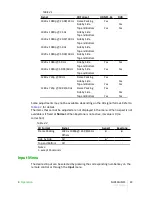
throughout the entire signal path
◦
highest available resolution, because video sources can deliver full
resolution content via HDMI only
◦
availability of 3D content, because most 3D compatible sources deliver 3D
content from HDMI only
◦
optimization of several image parameters (2D/3D content, color space,
aspect, signal range, over scan), thanks to auxiliary information (AVI
infoframe) sent by the source device together with the signal.
If your source has dual HDMI outputs, we would recommend direct
connection to the projector from one of the HDMI connections and the
second HDMI output to the input of an appropriate AV receiver/processor for
audio.
Sources with a DVI-D output can be connected to the HDMI input of the
projector using a suitable DVI-D to HDMI cable. In this case no auxiliary
information is sent from the source to the projector.
Note:
HDMI uses a code known as HDCP (High-bandwidth Digital Copy
Protection), which protects the recorded supports from being copied illegally.
The connection between the source and display require that the two devices
perform a handshake and exchange code keys before being able to display an
image. The InstaPort technology allows a simultaneous pre-authentification of
every attached device at the same it is connected, reducing drastically the
time required for HDMI source switching. For this reason you may note a
slight delay before the image appears on the screen, but it is perfectly normal.
•
Graphics RGB Input for Personal Computer and other sources that outputs
RGB or YPrPb signals. These sources must be able to provide separate H/V
sync or composite H+V sync.
•
RGB/YPrPb Input for DVD Players, Set Top Boxes and other sources that
output one of the following signals:
◦
Component (YPrPb)
◦
RGB with composite sync on green (RGsB)
◦
RGB with HV composite sync
RGB connectors also provides RGB input for SCART RGBS sources. See “
Video
”
below and “
RGBS Sync
” on page
30
.
•
Video This is the the input for composite video sources (such as VCR or
camcorders). This connector is also the composite sync input for SCART RGBS
sources. See “
RGB/YPrPb
” above and “
RGBS Sync
” on page
30
.
Control
You can connect the SUPERLUMIS projector to a Personal Computer or a control
system through one of the following methods:
•
RS-232 port, using a standard 9-pin straight serial cable
•
RS-232 port, using a USB to serial converter cable. In this case, installation of a
device driver provided by the cable manufacturer may be required
•
USB port, using a USB Type A (rectangular) to Type B (square) cable connector.
In this case, installation of a device driver provided by SIM2 may be required –
ask your SIM2 Authorized Dealer
3
Installation
SUPERLUMIS
User Guide
17
Summary of Contents for SUEPRLUMISHB
Page 1: ...SIM2 Multimedia SUPERLUMISEC SUPERLUMISHB User Guide ...
Page 43: ......
















































